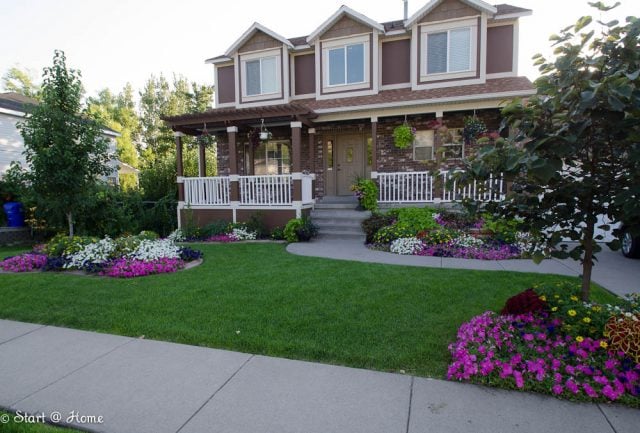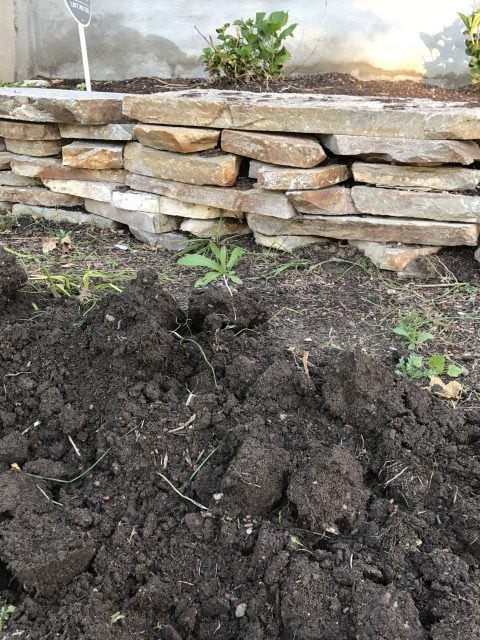Get a jump start on the basics of the growing season with these helpful steps to planting flowers for beginners.
Do you want to bring some colorful life into your yard but have no idea how to start? Planting flowers can be intimidating for the beginner gardener, but with a few helpful hints, that green thumb will kick in before you know it. This easy guide for the beginning gardener will show you the basics of planting flowers, cultivating your dirt and basic water maintenance.
Whether you’re a first time grower or an experienced plant lover who wants to learn more about growing beautiful flowers, this article provides the information you need to get started. Be prepared to get your hands dirty as you transform your flower bed to get the best results for that perfect flower garden.

Planting a flower bed is so simple, anyone can do it! Not to mention, the most abundant and beautiful flower garden is the result. Here are a few things to consider before we talk about the first step of flower planting basics.
Factors to Consider With Planting Flowers
- When to plant - This is based on where you live. For many of us, early spring is the best time to plant a new garden. However, early fall planting is also ideal to add in bulbs for spring or early summer arrival. Keep in mind that planting flowers in pots may also differ from garden bed planting.
- Types of flowers to plant - It's a good idea to be cautious when choosing your beautiful blooms. Get the right type for the right area of your yard, and especially for your appropriate climate. For example, you don't want a flower that requires mostly shade to be planted in an area that receives full sun all day. Also think about whether you want perennial flowers that come back year after year or annual flowers that must be planted each season.
- Different plants to add - In addition to flowers, decide if you want to incorporate any other ornamental grasses or shrubs into your plant selection. This can change how you landscape. But if you don't know that yet, don't worry. You can always shift and move plants later on.
- Water conditions - Think about the water conditions of where you live. If you are in more of a desert climate and restricted on watering, the most important thing will be to choose garden plants that reflect those limitations.
And don't fret if you don't know all of this information - most flowers and plants at your local garden center or nursery will provided this on the plant tag or packaging.
Helpful Garden Tools for Planting Basics
Here are some basic tools that I use on the regular for planting.
- Hand trowel or spade
- Miracle Gro
- Garden fork or hoe - to turn your dirt
- Knee garden pad
- Garden gloves
- Rake - for smoothing out your bed after turning your dirt
- Grampa's weeder - my favorite weeding tool for maintenance that doesn't break your back
6 Steps to Planting Flowers for Beginners
1. Prepare Dirt
Soil preparation is key when beginning your garden area, or even bringing life to your existing flower bed. The best way to begin preparing for healthy soil is to turn the dirt so it is soft to work with. This will allow for the plant roots to spread easier and grow. And this is especially helpful when your soil has been compacted down over the winter.
It will also make it easier to pull out any weeds that may have been hard because of tough or dry garden soil. Any kind of garden fork, hoe, or cultivator are great for this. When you have turned the soil surface, take a rake and smooth out the dirt for a level finish so you don't have mass clumps in random places.
A rich soil and optimal growing conditions can make all the difference when aiming for healthy plants. If you feel that your soil structure is lacking in nutrition, you can also mix in organic matter like compost to aid in plant growth. And of course, whatever you do to your ground soil, you will also want to do with a raised garden bed.

2. Prepare Flowers for Planting
When your soil is ready for planting, lay your new plants out and put them in a pattern or garden design. This will help you to see exactly what you need and to get everything in the right place before you plant. I get the best results when I choose types of flowers with a variety of color and group them together. It's also nice to have different flowers that are perennial plants as well as annual for diversity.
The tags or packages will usually say how far apart to plant each flower. I like to plant my flowers a little closer together than specified on the tag to create a look that is more full. When grouping flowers or plants together, remember to plant in odd number increments for optimal design.

3. Dig the Hole
Use a small hand spade to dig a hole for your plant. Make sure to dig your hole deep enough to cover all of the roots at the base of the plants. A great way to check this is to put either the container or the flower in the hole before you plant. If your roots are just below the top level of soil, you are good to go!

4. Add Fertilizer
For the next step, you'll want to add some extra nutrients by using fertilizer to encourage a healthy soil type. Add a small amount of fertilizer at the base of the roots when planting. Most packages will tell you how much you need to use. I use Doctor Earth Starter Fertilizer. This is an organic fertilizer that is safe for people and pets!
Just sprinkle a little bit at the base - but remember, less is more with fertilizer. You don't want to end up with plant burn from too much fertilizer. This can also kill your plants if overdone.


5. Fill the Hole
Make sure to fill in enough dirt that all of the roots are covered, leaving just the green stems and flowers showing at the top. Pack the soil well, but not so much that you break the stems.
6. Watering and Miracle Gro
Once your flowers are in, maintenance is key for successful growing. Most flowers really just need a few things to grow - the most important thing being a good water source and sunlight. Water your flowers daily if you can, especially in the heat of summer. On very hot days I will water a second time by hand later in the evening. It's very hard to overwater plants, especially in summer with the hours of sunlight and heat.
I also like to give my flowers a little extra nutrition so I add Miracle Gro to my watering time once a week. Fertilizing once doesn't give annuals enough food for their growth cycle. I fertilize once with a slow release fertilizer when planting and then use Miracle Gro once a week, so they can get all the nutrients boosts they need to become full, pretty flowers.


As you start planting your garden, remember that a successful endeavor can be achieved with the right knowledge. Knowing which flowers thrive in which climate, the correct spacing, and the proper depth to plant are key components to creating a flourishing garden. These 6 steps to planting flowers for beginners is just what you need to produce beautiful flower arrangements for an attractive curb appeal.
For more tips on planting flowers in pots for beginners, take a look here. And while you're at it, don't miss these 8 easy steps to get the most out of your flowers!
Happy Planting!
Brooke



Karen Seward says
Loved reading this, I used to plant flowers before my divorce and I have not planted any in 4 years, Actually I felt I forgot what to do, so reading this has helped me, Thank you so much.....Karen